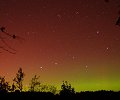
|
Aurora Gallery back to spaceweather.com |

|
|
Summary: On Sept. 30th a solar wind shock wave--a coronal mass ejection (CME) hurled into space by an explosion near sunspot 134--swept past Earth and triggered a moderate geomagnetic storm. No one knew it at the time, but that was just the beginning of nine days of geomagnetic activity. Solar wind gusts from coronal holes and a series of CMEs kept the storm going fitfully until Oct. 9th. Sky watchers spotted auroras, off and on, as far south as Arizona in the United States. |
|
|
| Photographer, Location | Images | Comments | |
 |
Paul
Anderson, Ulverstone Park, Tasmania, Australia Oct. 1 |
#1, #2, #3, #4, #5, #6, #7, #8, #9, #10, more | P. Anderson: "It was amazing. There were beams of light going right up to the zenith; some were a really cool green colour. There were also these pulses going through it, four per second."Photo details: Canon AE1 28mm lens at f/2.8 exposure time was 20 seconds on Konica 400 film. |
 |
Duane
Clausen, Menominee, Michigan, USA Oct. 2 |
#1, #2, #3, #4, more | D. Clausen: "After waiting through several hours of mediocre activity, I was rewarded with these photos just before sunrise on the morning of 10/02. The fog adds to the eerie but beautiful scene; you can see twilight creeping into the horizon." |
 |
Bob Colwell,
Somersworth, New Hampshire, USA Oct. 2 |
#1 | Photo details: Nikon N80 camera with Kodak Max 400 film, 28mm lens, 30 second exposure |
 |
Darrell Ruby,
near Elk, Washington, USA Oct. 1 |
#1, #2, #3, #4, more | D. Ruby: "For months now I have been following my wife Suzanne (her work is pictured below) from location to location trying to capture the auroras. This night finally produced some results. At times I didn't know whether to just stand there and watch or take pictures. It's new every time I view it." |
 |
Suzanne Ruby,
near Elk, Washington, USA Oct. 1 |
#1, #2, #3, #4, more | S. Ruby: "One long cloud sliced the Aurora up in pieces. It could have come from a contrail. But it stayed visible for two hours changing the looks of the aurora all though the night. It was a wonder to see. I asked my husband (Darrell) to stand very still in this one." |
 |
Robert
Smith, Near Stoneville, North Carolina, USA Oct. 2 |
#1, #2, #3, more | It's not every day you see auroras in North Carolina, but Robert Smith did on Oct. 2nd. Photo Details: Fujicolor 200 and Kodak Gold 800 film. |
 |
Stephane
Levesque, Luceville, Quebec, Canada Oct. 2 |
#1, #2, #3 | Photo details: 28mm, 800 asa at 15 seconde |
 |
Joachim
Persson, north of Stockholm, Sweden Oct. 1 |
#1 | J. Persson: "[These were] strong mostly green aurora that could be seen quite well, despite some heavy light pollution. The pictures where taken with a Canon S40, 10-15 sec exposure. f2.8 and sensitivity set to 200ASA." |
 |
Lance Taylor,
Edmonton, Alberta, Canada Oct. 2 |
#1, #2, #3, #4 | L. Taylor: "This display was so huge and bright that I was shooting on ISO 100 within the city near downtown. ...best display I've seen in my lifetime from these parts!" The strange-looking building in many of these pictures is the Odyssium (formerly Edmonton Space & Sciences Centre) |
 |
Warren
Justice, Riding Mountain National Park, Manitoba, Canada
Oct. 1 |
#1, #2, #3, #4, #5, #6, #7 | W. Justice: "This was one of the better displays that I have seen in this area. My son Jairus and I were very fortunate to witness it!" Photo #7 includes the International Space Station. Photo details: 28mm f1.9 @ 12-15sec. on Fuji Superia 800 x-tra |
 |
Mark Simpson,
Calgary, Alberta, Canada Oct. 1 |
#1, #2, #3, #4, more | Photo details: Sony Dsc-F707 Digital Camera. f2.0. Exposure: 30 seconds |
 |
Sandra Barnett,
Sublimity, Oregon, USA Oct. 2 |
#1, #2, #3 | Photo details: 400 speed color print film, 50 mm lens, 2.8 f-stop, 30-60 sec exposures |
 |
David Johnston,
Duvall, Washington, USA Oct. 2 |
#1, more | Photo Details: Nikon D1x, 30-sec, f2.8, 800 ISO (26mm) and dark frame subtracted |
 |
Mats Mattsson,
an island south of Stockholm, Sweden Oct. 1 |
#1, more | Photo details: Film Fuji Provia 400F, Lens Minolta MD 20 mm @2.8, Exposure time 20 sec |